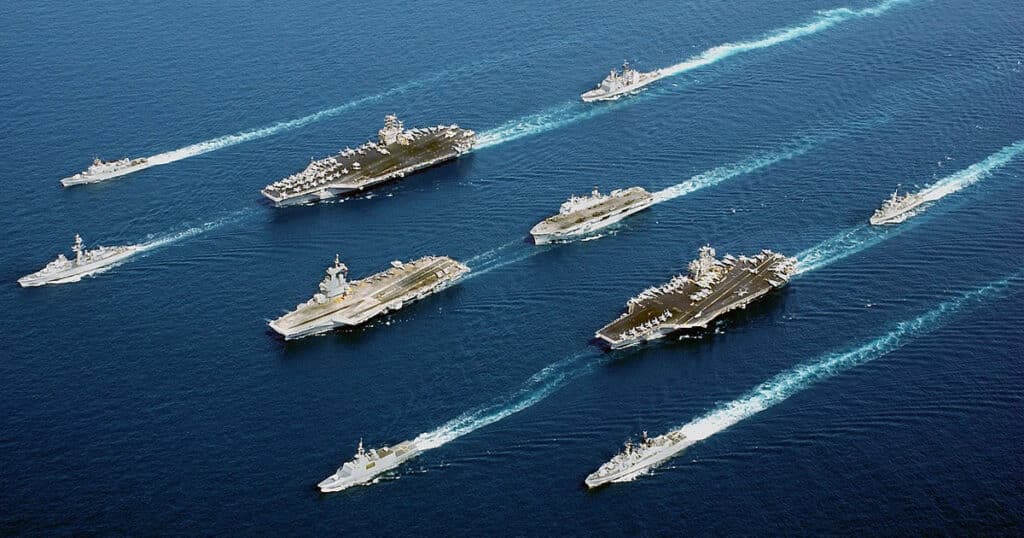
A New Way of Thinking About Naval Power
For the United States to credibly deter China from war, ships are needed now, not decades from now. The lack of available ships in the Navy’s fleet has eroded the deterrent effect of America’s sea power and unless current plans and policies are radically altered, China’s power will remain unchecked and undeterred.
The abysmal state of our maritime industrial base makes the goal of a 380 ship Navy seem like fantasy and the idea of scrapping existing ships to build new destroyers and a new frigate perverse.
Two retired Naval Service officers have proposed a solution that is doable, affordable, and common sense in the near term. Colonel TX Hammes and Captain R. Robinson Harris, writing in the Naval Institute’s Proceedings, have proposed putting missiles and lethal reconnaissance drones aboard converted commercial ships in launch containers. This makes eminent sense for several reasons.
First, the hulls already exist. This would go a long way to easing the Navy’s shipbuilding woes until the industrial base problem gets solved.
Second, because merchant vessels are highly automated, the need for additional manning would be minimal and can be tasked to the merchant mariners being a purely defensive weapon, thus leaving the Navy to focus on reaching their goals of readiness and lethality.
Manning the Merchant Marines and the U.S. Navy is yet another headwind facing the current maritime crisis. Recruiting is a problem for all the services. Although President Trump hopes Secretary of Defense Pete Hegseth will help to entice recruits through invigorating the military’s core mission of warfighting and lethality.
Although early, recruiting numbers are ticking upward and it is relatively easy to recruit trained merchant seamen to man the Navy-Marine Corps Maritime Pre-positioning Ship Program which is now moribund due to some poor decisions on the part of the Marine Corps and a lack of attention to the ailing merchant marines by an poorly managed Maritime Administration.
Hammes and Harris also correctly note that the number of combatant ships in the fleet is less important than the amount of firepower they can generate – a more lethal warfighting fleet. This was the secret of the royal Navy in the Days of Admirals Hood, Rodney, and Nelson. Well drilled British tars could generate a third to a half more firepower in an engagement than their Spanish and French foes.
The authors point out that eight of these “fireships” could be purchased for the price of a single frigate and at the current capability of American shipyards, by my estimate sixteen such fireships could be procured before a single frigate could be launched. In addition, container ships are very hard to sink.
However, as the authors point out, the fly in the ointment here is that the Navy cannot procure enough missiles to supply the ships that it has today much less equip the fireships. The good news here is that the United States can increase its capability to produce missiles and drones much faster that it can build ships.
I have been a “rocket-in-the box” advocate for a long time. In these pages and other publications (Beyond Mahan: A Proposal for a U.S. Naval Strategy in the Twenty-First Century), I have advocated strapping enhanced combat modules on warships deemed obsolete by the Navy, such as the Ticonderoga class cruisers rather the turning to them into razor blades or coral reefs which the Navy has also done with its large deck amphibious fleet.
This is why we can no longer provide a 24/7 Marine Corps presence in the world’s worst trouble spots. Instead, the Navy is planning on producing overpriced, and useless, Landing Ship Medium (LSM) to support a failed Marine Corps operational strategy to fire obsolete anti-ship missiles from islands in China’s first island chain. Cancellation of the LSM program would go a long way toward affording fireships ships and enough real amphibs to present a credible deterrent to China and globally.
Beyond the scope of Hammes and Harris’s concept for arming merchant ships but complementary is the use deception in the event of conflict. Large merchant ships can also be used as “lily pads” for VSTOL F-35 strike aircraft to get closer than large aircraft carriers to help degrade the Chinese reconnaissance-strike complex.
Purchasing obsolete merchant vessels to become robotized decoy fireships would make the Chinese targeting problem more difficult. Wasting resources and missiles, the Chinese would also be creating a targeting signature for the U.S. Forces.
Employing this concept would provide the first step in degrading the Chinese reconnaissance-strike complex allowing aircraft carriers and amphibious assault ships freedom of movement to advance power projection through distributed maritime operations.
Change is needed now if the U.S. expects to credibly deter the China from armed conflict in the Indo-Pacific or win if a war is forced upon us.
The imminent, needed change must be thrust upon the admirals by the Secretary of Defense and the new SECNAV in coordination with Congress. While DOGE has been lightning fast with uncovering fraud waste and abuse, they are not navalists, but together they can reverse the current losing business model and right the ship toward maritime dominance America was once known for.
Gary Anderson is a retired Marine Corps Colonel who was Chief of Staff of the Marine Corps Warfighting Lab. He served as a Special Advisor to the Deputy Secretary of Defense.
This article was originally published by RealClearDefense and made available via RealClearWire.



